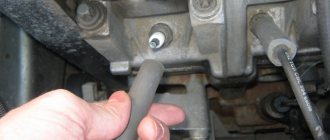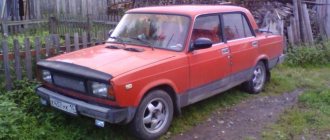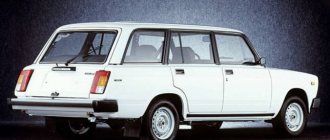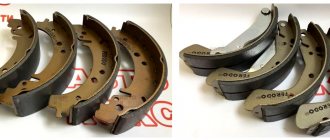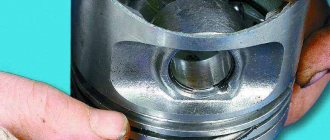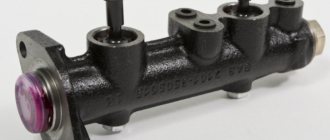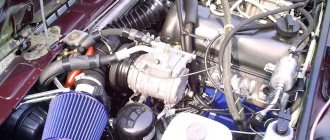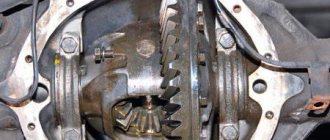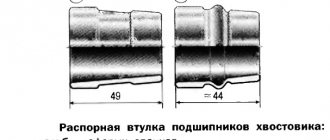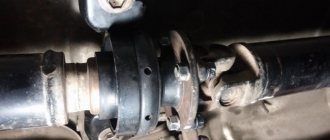Currently, AvtoVAZ OJSC manufactures drive axle gearboxes for the following models for production vehicles and supplies them for retail sale:
- VAZ 2101 (gear ratio 4.3),
- VAZ 2103 (gear ratio 4.1),
- VAZ 2106 (gear ratio 3.9).
The gear ratio is the result of dividing the number of wheel teeth by the number of gear teeth. You don't need to count the teeth at all. On the driven gear you can read all the necessary information.
For example, the marking “VAZ 2106 1143 4537” should be interpreted as follows:
- “VAZ 2106” - gearbox model;
- “1143” - 11 teeth on the gear, 43 teeth on the wheel;
- “4537” is the number of the main gear set.
Therefore, the gear ratio of this gearbox is: 4311=3.9. As you can see, the manufacturer of the gearboxes introduced the name of the car model “VAZ 21**” into their markings. This fact often misleads the consumer. So, for example, owners of VAZ 04, 05 and 07 models, out of ignorance, are looking for a gearbox from a “four”, “five” or “seven”, and owners of VAZ 21063 cars (engine capacity 1300 cc) “safely” install a “sixth” » gearbox with gear ratio 3.9. And then they wonder why the car has become “stupid”: the acceleration dynamics have sharply decreased, and despite the fact that a high-speed gearbox is installed, it cannot be accelerated to a speed of more than 120 km/h.
Meanwhile, the marking “VAZ 21**” does not mean at all that this particular gearbox is intended for this car, for example: gearbox 2101 is for a VAZ 2101 car, and gearbox 2103 is for a VAZ 2103 car, etc. The overall and mounting dimensions of all gearbox models are the same. In other words, all gearboxes of VAZ cars are structurally interchangeable. But it is necessary to take into account a number of significant limitations associated with a specific gearbox and vehicle model. Let's take a closer look at these restrictions.
Gearbox repair
Currently, AvtoVAZ OJSC manufactures drive axle gearboxes for the following models for production vehicles and supplies them for retail sale:
- VAZ 2101 (gear ratio 4.3),
- VAZ 2103 (gear ratio 4.1),
- VAZ 2106 (gear ratio 3.9).
The gear ratio is the result of dividing the number of wheel teeth by the number of gear teeth. You don't need to count the teeth at all. On the driven gear you can read all the necessary information.
For example, the marking “VAZ 2106 1143 4537” should be interpreted as follows:
- “VAZ 2106” - gearbox model;
- “1143” - 11 teeth on the gear, 43 teeth on the wheel;
- “4537” is the number of the main gear set.
Therefore, the gear ratio of this gearbox is: 4311=3.9. As you can see, the manufacturer of the gearboxes introduced the name of the car model “VAZ 21**” into their markings. This fact often misleads the consumer. So, for example, owners of VAZ 04, 05 and 07 models, out of ignorance, are looking for a gearbox from a “four”, “five” or “seven”, and owners of VAZ 21063 cars (engine capacity 1300 cc.
Meanwhile, the marking “VAZ 21**” does not mean at all that this particular gearbox is intended for this car, for example: gearbox 2101 is for a VAZ 2101 car, and gearbox 2103 is for a VAZ 2103 car, etc. The overall and mounting dimensions of all gearbox models are the same. In other words, all gearboxes of VAZ cars are structurally interchangeable. But it is necessary to take into account a number of significant limitations associated with a specific gearbox and vehicle model. Let's take a closer look at these restrictions.
All VAZ classic cars are rear-wheel drive, the vehicle moves using the rear axle, which is the drive axle. The VAZ rear axle gearbox is the most important part in the transmission; it is where the main gear is located.
The slowest one is the RZM 2102, its drive gear has 9 teeth, and the driven gear has 40 teeth. To calculate the gear ratio, you need to divide the number of planetary gear teeth by the number of teeth on the drive shaft; for the VAZ 2102 the drive gear is equal to 4.44.
The “penny” gearbox (2101) accordingly has the number of teeth on the gears 10/43, so its IF is 4.3. The next, faster one is RZM 2103 - it has a ratio of 1041, which means the gear ratio is 4.1. And finally, the “fastest” will be the 2106 gearbox, with the number of teeth 11/43 and an inverter frequency of 3.9, respectively.
Many VAZ 2101-07 owners strive to install the fastest gearbox, but this is not always necessary. If the car often carries cargo, that is, the car is a “workhorse”, high speed is of no use, but high-torque power will be very useful. It should be noted that RZM 2102 was not supplied as spare parts; it was installed only on station wagons.
The VAZ 2107 is the last car from the rear-wheel drive VAZ series - it began production later than all of them and was in production the longest of all the “Classics”; its production ended in 2012. All types of gearboxes were installed on the machine, except 2102; the choice of RZM depended on the type and power of the engine.
The main disease of REM is increased noise (hum), and the gearbox can hum for various reasons:
- there is insufficient oil in the bridge, or it is completely missing;
- the gap between the gears of the main pair is not adjusted;
- the gears are worn out, they have chips and other damage;
- the main pair has a manufacturing defect, the gears are not ground in from the factory;
- the shank nut has become unscrewed or loosened;
- bearings are worn out.
The main malfunction of the center differential is the wear of the gears of the axle shafts and satellites, when the surfaces of the parts are heavily worn, play forms between the differential gears, but the rear axle usually does not make noise due to wear of the differential gears.
ZM gearboxes on VAZ classics can be repaired, but only if there is no wear on the gears. If the mechanism can no longer be repaired, it needs to be replaced. We replace the rear axle gearbox of a VAZ 2106 on a “seven” as follows:
- we install the car on a pit or a car lift; changing the gearbox on the ground is extremely inconvenient;
- if the car is installed on a pit, it is necessary to jack up both sides; in any case, the rear wheels must be removed. If the work is not done on a lift, you should install stops under each side of the car (in the rear);
- unscrew the drain plug in the REM, drain the transmission oil, having previously prepared a container for it;
- remove the rear brake drums (two guide bolts on each side), after first removing the car from the handbrake. The drums can be difficult to remove; they are dismantled by tapping them from behind with a hammer through a wooden block. You cannot hit the drum with a metal hammer; the drum may break;
- remove the brake pads;
- unscrew the fastenings of the rear axle axle shafts on each side, each axle shaft is secured with four nuts;
- we press out the axle shafts, for this you will need a special puller, you can also make a homemade device;
- remove the driveshaft by unscrewing the four bolts and nuts. If the same REM is installed, the cardan with the shank must be marked; this is done in order to put the shaft back in the same position. If you install the cardan incorrectly according to the marks, the shaft may begin to vibrate;
- unscrew the eight bolts securing the rear gearbox (key 13), remove the assembly.
At this point, the removal of the gearbox can be considered complete; now all that remains is to either repair the mechanism or install a new one instead.
If the main pair in the gearbox is worn out, it must be replaced. But you can’t just put the gears back in place; the gaps in them must be adjusted. In total, two types of basic adjustments are made:
- The thickness of the adjusting sleeve (washer) is selected for the shank (drive gear). The washer can have a thickness from 2.6 mm to 3.5 mm;
- The gap between the gears of the main pair is adjusted using two adjusting nuts of the differential housing.
The washer for the shank is selected in such a way that the shaft with the drive bevel gear rotates in the gearbox housing without backlash with a force by hand (0.3-0.4 kg). In this case, the shank nut should be tightened with a force of 12 to 26 kg, usually 18-19 kg are tightened.
After installing the shank, the differential housing with the planetary gear attached to it is put in place. The housing is secured with two covers (4 bolts, a knob with a 17mm head). The adjusting nuts are tightened from the sides of the bearings, the differential is installed so that there is play between the gears of the main pair, and the planetary gear should not be clamped.
The last stage is to adjust the preload of the differential bearings; the adjusting nuts are tightened from the sides. This work must be done with an indicator; the device should show from 0.14 to 0.18 mm, the gap between the gears should be within 0.08-0.13 mm. After the operation, the adjusting nuts are fixed with plates so that they do not turn.
It should be noted that adjusting the VAZ rear axle gearbox is a very difficult matter, and it is better to trust it to professionals.
Car owners of VAZ classics often cannot decide what is best to do - buy a complete ready-made REM assembled or purchase individual parts and repair the gearbox. It’s really difficult to decide here - the price of a new gearbox, of course, is higher, but the owner of the car is freed from the headache of adjustment. The thing is that it’s not so easy to find a good specialist in VAZ gearboxes, and there is no guarantee that the new main pair will not hum.
If a car owner buys a new gearbox, but it hums, the part can be exchanged under warranty, but the car owner loses money on removing and installing the gearbox. If you purchase a defective main pair, the repair itself will be more expensive - you will have to pay a technician for a secondary overhaul of the gearbox.
On VAZ 2101-07 vehicles, the factory does not provide locking of the center differential, but the industry already produces both differentials with locks and fully assembled 3M gearboxes. The most common today are REMs with screw locking; in them, the differential gears are locked depending on the load.
Locking the VAZ rear axle gearbox provides the following advantages:
- increases cross-country ability, allows the vehicle to avoid slipping on difficult road sections;
- allows the car to accelerate faster at the start;
- The car corners more confidently.
But ZM gearboxes with screw locking also have their disadvantages:
- Fuel consumption increases slightly;
- when accelerating, the car handles worse;
- The differential and assembled gearbox with locking are much more expensive than standard parts (the price is approximately 2-2.5 times higher).
VAZ 2101-07 car owners should know that after installing the RZM with blocking, the car will not become an SUV, and it will not be able to move on severe off-road conditions.
Cars differ in the type of drive they have, and while today most passenger vehicles have front-wheel drive, rear-wheel drive used to be more popular. Most domestically produced models were produced with rear-wheel drive, and the VAZ 2107 was no exception. The gearbox fails to influence factors such as vehicle power and speed.
Best answers
Which gearbox is better for the classic VAZ 2107 2105 2106 2103 2101
rear axle gearbox VAZ classic 2101 2107 2106 2105 2104 2103 Currently, JSC AvtoVAZ manufactures for production vehicles and supplies for retail sale drive axle gearboxes of the following models: VAZ 2101 (gear ratio 4.3), VAZ 2103 (gear ratio 4.1), VAZ 2106 (gear ratio 3.9). The gear ratio is the result of dividing the number of wheel teeth by the number of gear teeth. You don't need to count the teeth at all. On the driven gear you can read all the necessary information. For example, the marking “VAZ 2106 11\43 4537” should be interpreted as follows: “VAZ 2106” - gearbox model; “11\43” - 11 teeth on the gear, 43 teeth on the wheel; “4537” is the number of the main gear set. Therefore, the gear ratio of this gearbox is: 43\11=3.9. As you can see, the manufacturer of the gearboxes introduced the name of the car model “VAZ 21**” into their markings. This fact often misleads the consumer. So, for example, owners of VAZ 04, 05 and 07 models, out of ignorance, are looking for a gearbox from a “four”, “five” or “seven”, and owners of VAZ 21063 cars (engine capacity 1300 cc) “safely” install a “sixth” » gearbox with gear ratio 3.9. And then they wonder why the car has become “stupid”: the acceleration dynamics have sharply decreased, and despite the fact that a high-speed gearbox is installed, it cannot be accelerated to a speed of more than 120 km/h. Meanwhile, the marking “VAZ 21**” does not mean at all that this particular gearbox is intended for this car, for example: gearbox 2101 is for a VAZ 2101 car, and gearbox 2103 is for a VAZ 2103 car, etc. Overall and mounting dimensions All gearbox models are the same. In other words, all gearboxes of VAZ cars are structurally interchangeable. But it is necessary to take into account a number of significant limitations associated with a specific gearbox and vehicle model. Let's take a closer look at these restrictions.
What kind of gear, planetary gear or shank do you need? Go to Yandex and look at the rear axle gearbox or differential
This is interesting: At what mileage should you change the timing belt?
Features of VAZ-classic rear axle gearboxes
For all-wheel drive vehicles, the front and rear axle ratios must be the same.
In everyday practice of car maintenance, quite often there are cases of installing gearboxes with different gear ratios on an all-wheel drive vehicle (Niva, Taiga). Most often this happens due to the lack of appropriate knowledge among those people who repair the car. These can be both car owners who repair the car themselves, and unskilled car service workers who provide services to the population to replace units.
When installing a gearbox with a gear ratio different from the required one on an all-wheel drive vehicle, the owner will not notice any disturbances in the operation of the transmission. The car will drive normally until the owner tries to engage the center differential lock. The fact is that this differential “works out” the difference in gear ratios of the gearboxes while driving.
A simple, but quite dangerous for transmission units, method of checking for differences in gear ratios in gearboxes is as follows:
- Place the vehicle on a dry, level road with a slight slope to move forward.
- Check the vehicle's ability to roll freely downhill when releasing the brakes in neutral. The slope should be small, but sufficient for the car to move on its own.
- Engage the center differential lock (transfer case) and allow the vehicle to roll downhill.
If the car rolls as freely as in the test according to point No. 2, the gear ratios are the same. If, with the center differential locked, the car is unable to roll in neutral, the gear ratios are different.
Operating a vehicle with different gear ratios is unacceptable. Therefore, before installing a new unit on a car, you should ask what models of gearboxes are installed on the car. KEMP specialists will help you evaluate them without disassembling the car.
Cars with rear-wheel drive, as already noted, are equipped with gearboxes with different gear ratios. The transmission configuration of modern cars is difficult to predict.
So, for example, during the years of production of the VAZ 2102* car, one could say with confidence that it had a gearbox with a gear ratio of 4.44. The modern generation of “twos” - VAZ 2104 * - is usually equipped with a gearbox with diametrically opposite parameters - VAZ 2106, 3.9. This is very unusual for a utility vehicle, but the manufacturer is guided by its own considerations.
In order not to make a mistake, the main condition for replacing a faulty unit with a working one should be observed: whichever gearbox model was removed, this should be installed.
When replacing one gearbox with another, with a different gear ratio, not only the dynamic characteristics of the car change, but also the speedometer and odometer readings.
Example: if there was a standard gearbox 2102 (4.44), and instead of it a 2106 (3.9) was installed, the speedometer and odometer readings must be multiplied by 1.14, i.e. the car will become 14% “weaker”, but “faster” by the same 14%.
“Weaker” means that the engine's effective torque (in this example case) will be reduced by 14%. Outwardly, this manifests itself in a decrease in the car’s throttle response and worsening acceleration dynamics.
It is more convenient to explain the term “faster” using a figurative example: if a car with a 4.44 gearbox, in order to develop a speed of 120 km / h in direct (fourth) gear, it is necessary to “spin” the engine to 4400 rpm. crankshaft, then with a 3.9 gearbox for the same speed you will need only 3900 rpm... But to reach 3900 rpm.
, an engine with a displacement of 1200 cm3 may not have enough torque or, simply put, power. Thus, the term “faster” in this context is used in the following sense: at the same engine speed, a gearbox with a lower gear ratio allows the car to move at a higher speed. However, it should be remembered that a gearbox with a lower gear ratio requires a proportional increase in engine power.
In order for the speedometer and odometer readings to correspond to the actual values, the gearbox must have a speedometer drive that matches the gear ratio of the installed rear axle gearbox.
Warning!
The speedometer drive cannot be replaced from one to another by simple rearrangement, since it is necessary to replace the next gear (catalog number 210*—170 21 5, corresponding to this drive, on the secondary shaft of the gearbox.
It would seem that nothing can be improved on the classics. However, there are 3 options for gearboxes and 4 rear axle gearboxes. The gearboxes come in 2101, 2105, 2106. The gears (1st, 2nd, 3rd) in 2101 are shorter than in 2105, and longer in 2106. Gearboxes come with gear ratios of 3.9, 4.1, 4.3, 4.44.
- drain plug;
- filler plug;
- driving and driven gears;
- oil seals or cuffs;
- differential;
- axle shafts;
- bearings;
- locking plate;
- breather for releasing excess pressure inside the mechanism.
The final drive is based on the drive and driven gears. High-quality longitudinal sliding of these two gears is ensured by hypoid engagement. This has a positive effect on the service life of gears, as well as reducing noise during the operation of rare earth metals. It is through these gears that the torque value is changed.
Now let's return to our "seven". VAZ 2107 cars are equipped with two types of gearboxes. These are mechanisms with high and low gear ratios. How to determine what type of rear axle device is installed on a VAZ 2107 vehicle? To do this, you need to look at the technical passport of the car, which indicates the exact model of the vehicle.
If the technical passport indicates a modification of the VAZ-2107 or VAZ-21073, this means that the vehicle is equipped with a model of the unit with a higher gear ratio, which was intended for the VAZ-2103. A higher gear ratio indicates that the gears have more teeth. This significantly affects parameters such as vehicle speed and power or traction.
On a VAZ 2107 with a gearbox from a VAZ 2103, the acceleration dynamics are 10 km/h lower, but at the same time such cars perform well when transporting heavy loads transported in trailers. If the technical passport indicates a modification of the VAZ 21074, then this indicates that such a car is equipped with a mechanism from the VAZ 2106.
This type of mechanism is equipped with fewer teeth, so it is faster. If on a “three” the gear ratio is 4.1, then on a “six” this value is 3.9. The “Seven” with such a device is more resourceful, but at the same time has less tractive effort. If we talk about the number of teeth, then on the mechanism from the VAZ 2103 their number is 10/41, and on the VAZ 2106 it is 11/43.
The differences in the gearboxes of the rear axle of the VAZ-2107, although not significant, it is important to understand that if you install the mechanism from the VAZ-2106 on the “seven”, then the speedometer and odometer readings will lie by 10 km/h. At the same time, it is also important to understand that the mechanism from the VAZ-2106 will affect the reduction in fuel consumption. Which gearbox should you install on your VAZ 2107? It all depends on what is more important - strength or speed.
Cars of the LADA family, starting from VAZ 2101 and up to VAZ 2107, are not equipped with a cross-axle differential lock. However, today there are locking differentials, as well as fully assembled gearboxes. Devices with screw locking are very popular today.
- Increased vehicle cross-country ability.
- Accelerated acceleration.
- Confidence when cornering.
Before installing such a mechanism, you should think about the disadvantages:
- Increased fuel consumption.
- Control deteriorates during acceleration.
- A differential together with a gearbox will cost much more than just one gearbox.
It is important for owners of vehicles from the “kopek” to the “seven” to know that installing a RZM with a differential lock will not turn your car into an SUV.
In conclusion, it should be noted that before resorting to replacing the gearbox, you should consider whether it is worth it. You need to weigh all the pros and cons, and then start doing the work.
The graph shows the dependence of vehicle speed on engine speed with different main pairs in the gearbox (with unchanged gearbox ratios)
As can be seen from the graph, the higher the ratio of the main pair in the gearbox, the faster the machine picks up speed, but at the same time the maximum speed is lost. Therefore, when choosing the main pair, you need to take into account the degree of engine preparation and the type of behavior of the machine. For each gear change, time is spent, both on the process of changing gears and on the time the clutch slips.
In the case of a short main pair, we have a very good level of acceleration, but for a very short time, and we have to take more frequent breaks in acceleration to change gears, which negates all the advantages of a short main pair.
On the other hand, in rallies, short GPs enjoy well-deserved success, as do the rows of gearboxes that are as close as possible, in order to have the maximum possible speed at any point in any turn, so rally drivers sacrifice both maximum speed and acceleration on a straight line in order to always have the correct gear when turning. But in the case of drag, everything is different, and those with a relatively weak engine are saved by a short transmission and finish at the cutoff in 5-6 gears.
In addition to gearboxes with a standard gear ratio, there are “sports” gearboxes with a gear ratio of 4.78 5.13 5.38.
- VAZ 2101 - gear ratio 4.3
- VAZ 2102 - 4.4
- VAZ 2103 “troika” - 4.1
- VAZ 2106 “six” - 3.9.
- VAZ 2103 - 4.1;
- VAZ 2106 - 3.9.
Some service issues
If there are no design differences in terms of the internal structure, they are encountered when servicing the rear axle gearbox. First of all, this is dismantling. There are no special problems with rear-wheel drive cars from Tolyatti. But with the Gazelle of early releases they appear: the entire rear axle was non-separable, forming a single unit with the gearbox. Although it gained in reliability, it nevertheless lost in service. There are no difficulties with vehicles produced in recent years.
Many car enthusiasts are interested in the question of whether it is possible to install gearboxes designed for cars of other brands on their cars. The answer from experts is usually clear: if you have never had to do this, then it’s better not to start. The fact is that the parameters of the rear axle unit are directly related to the characteristics of the engine and the design of the gearbox. If the “internals” of the VAZ-2107 and VAZ-2106 are identical, and there is no difference in such replacements, then with the Gazelle the situation is somewhat different.
It is possible to install a similar unit from the “related” Sobol on the Gazelle, and due to this the car will receive a certain “agility”, but the wear period will be reduced.
Having certain skills in servicing passenger cars, an experienced car enthusiast will be able to diagnose and repair the rear axle gearbox of the “classic” Volzhsky Automobile Plant without any problems. But with Gazelle it’s already more difficult. It is better to entrust all necessary manipulations to an experienced car mechanic. This is also associated with such a problem as removing the filler plug of the rear axle. Without special devices, even such a small thing turns into an impossible task.
Device diagnostics and maintenance
It is best to entrust the maintenance of any car to service specialists also because transmission oils, no matter what markings they have, are still quite liquid in consistency. If there are any problems with the rear axle gearbox, then it is also necessary to replace the gaskets and seals, check the breather, bearings, and so on. No one can do this better than a specialist.
Where are the gear ratios written?
Raise the rear wheel, put it in neutral, make 10 rotations of the wheel and count the revolutions of the cardan.
Cardan speed 19.5 20.5 21.5 22.5
Gear ratio 3.9 4.1 4.3 4.44
What does the gear ratio give? The higher it is, the lower the speed in all gears at the same speed. On standard sixes with a 1500 engine, a 2105 gearbox and a 4.1 axle are installed at the factory. If the engine is 1600, then the gearbox is original (2106), the axle is 3.9 or 4.1.
Let's assume that all cars have 175/65R13 tires.
Let's now look at the graph of the dependence of the car's speed on the engine speed (always on the graphs the standard 1500 with a 2105 gearbox and a 4.1 axle will be indicated in green. Why - because there are more of them than all the others).
With a 2106 gearbox and a standard 4.1 axle (raspberry) with a standard engine, we get a gain in dynamics only due to the long 1st gear, the 2.3 has become longer, which is not good (with a standard engine).
Here all the gears are longer (especially the first). For example, in our version in first gear the speed range of 3500-6500 is at a speed of 28-53 km/h, and in the standard it is at 25-45 km/h. Feel the difference! By the way, in this configuration, the first, second, third gears completely coincide with the 11th row on the chisels (with a 3.7 axle), the fourth is shorter, and if the fifth, then it is not much longer than the chisel fourth gear... truly, everything new is well forgotten old :).
Another thing is if we install a bridge of 4.44 (raspberry): Compare: 1 is longer, 2.3 is shorter, 4 is shorter!!
That is, from a traffic light in first gear, we rev up the engine when the “standard” is already shifting to 2, then second, third, fourth, and we go forward.
This option is optimal for a standard engine. However, there is a minus: in 4th gear, already at 140 km/h the revolutions will be 6000... here it is better to use standard 5th gear, which will create a complete picture. Here you have the highway, and the city - and the wolves are fed up and no one was hurt. And due to the fact that at maximum speed modes the revolutions will be close to maximum, the dynamics on the track will be amazing.
- Always correctly replace a faulty gearbox or its parts;
- understand how the car will behave when installing a gearbox with parameters different from the original factory ones.
The easiest way to find out the gear ratio of the rear axle of a car is to look in the documentation. For many foreign cars this number is encrypted in the Vin number. For domestic cars, there are standard gearboxes for certain models. At the same time, there are cars that can be equipped with a number of gearboxes with different gear ratios.
It is possible to find out information specifically and in detail. There is no need to remove the gearbox for this. If there is information, it is located in a place convenient for inspection.
What happens if the gearbox being replaced has different parameters from the installed ones? For example, consider the gear ratios of VAZ gearboxes. The line of units is represented by four gearboxes. Their numbers fall in the range from 3.9 to 4.44.
A gearbox with a number of 3.9 will be the fastest of the family, and a gearbox with a number of 4.44 will be the most high-torque. Because in the first case, the power transmitted by the input shaft decreases only 3.9 times versus 4.44. It turns out that if the gearbox transmits torque faster, the car becomes more “nimble”. If you replace the gearbox with a version with a lower gear ratio, the car accelerates more slowly, but becomes more passable and high-torque.
When installing a gearbox with a number different from the factory number, it is imperative to check the speedometer readings. Most often he starts to lie. The problem can be solved by adjustment, and sometimes you have to change the speedometer cable. The most difficult thing when replacing a gearbox is not the removal and installation, as it might seem initially, but the adjustment and configuration. Without proper adjustment, even a properly selected gearbox can become unusable after several thousand miles.
What gear ratio of the VAZ rear axle gearbox can be considered optimal? Each Zhiguli car owner will decide the answer to this simple question himself. To do this, it is enough to understand for what purposes the car will be used. If this is primarily a workhorse, the best option would be the most powerful gearbox with a 4.3 number.
A few words about the gear ratio of all-wheel drive VAZ-2121 gearboxes. Since there are two gearboxes on such cars, it is important that the number is the same and corresponds to the ratio 41: 10 = 4.1.
To complete the picture, let’s consider foreign versions of gearboxes and their numbers. A good option for comparison would be the rear-wheel drive models of the German auto giant BMW. BMW gear ratios range from 3.07 to 4.1. Moreover, the number of unit models exceeds ten. Just from this indicator you can understand how often foreign designers make changes to car components.
The most dynamic gearbox with a number of 3.07 is found in models of the E90, E91 and E92 series. If we look at powerful options, we can highlight the BMW X5 with a 3-liter engine, which has a rear gear ratio of 4.1.
Another thing - if we install a bridge of 4.44 (raspberry): Compare: 1 is longer? 2,3-shorter, 4-short!!
Answers from experts
There are two gears and they always go in pairs. On 06 11 on the drive and 43 on the driven On 03 10 and 41 teeth On 01 10 and 43 teeth
In general, when the gearbox is removed, turn the driven gear and you will see a strictly stamped marking like this: 10/43 is 01 or 10/41 is 03 or 11/43 is 06
01-41, 03 -38, 06 - 36 BUT this is all approximate! Since there are 063, 065, etc. There is a difference in the gear ratio in both the gearbox and the gearbox.
Depends on what engine and what gearbox
Dmitry Levin:
Rear axle gearboxes on classics differ in gear ratio.
3.9 (43/11) — 21043,21053,2107,21074
4.1 (41/10) — 2101,21011,21013,2103,2104,2105,21053,2107,21072
4.3 (43/10) — 2101,21011,21013,2104,2105,21051,21072
The smaller the bridge, the faster the bridge will be; the larger the bridge will be for traction!
Gearbox device
In order for the car to move, it is necessary to transfer the rotation of the engine to the wheels. But the engine speed is too high, and in order to correctly distribute the torque, a mechanism is needed that changes the gear ratio. Due to the gearbox and different engine speeds, the speed of movement changes, and the main pair of the rear axle takes over the rotation and transmits it to the wheels through gears.
- flange, it is fixed on the drive gear (shank) of the RZM, and is an intermediate link between the driveshaft and this gear;
- the shank of the main pair, at one end of which there are splines for pressing the flange, at the other end there is a bevel gear with a small number of teeth;
- driven gear (planet gear), it is in mesh with the drive gear, and it is with it that it forms the main gear;
- center differential, allowing the rear wheels to spin at different angular speeds.
The differential design is very simple - the mechanism consists of two axle gears, two satellites and a satellite pin. From the gearbox, the movement is transmitted to the axle shafts, on which the wheels are mounted.
The design of the RZM is typical of the “classic” VAZ. The main components of the gearbox are the planetary gear and the center differential.
The main components of the rear axle gearbox of the VAZ 2103 are a planetary pair and a center differential
The VAZ 2103 gearbox consists of:
- Bevel drive gear.
- Planetary driven gear.
- Satellites.
- Semi-axial gears.
- Satellite axes.
- Differential boxes.
- Mounting bolts for box bearing caps.
- Differential box bearing caps.
- Bearing adjusting nut.
- Gearbox housing.
Planetary pair
The driving and driven gears, called the planetary pair, form the main gear of the rare earth metal. The axes of these gears are offset from each other and cross without intersecting. Thanks to the use of specially shaped teeth, an optimal engagement spot is obtained. The design of the gears allows several teeth to engage simultaneously. At the same time, more torque is transmitted to the axle shaft, reducing the load on each tooth and increasing the durability of the mechanism.
The VAZ 2103 planetary pair consists of drive and driven gears
Bearings
The drive gear is held by two roller bearings of type 6–7705U and 6–7807U. To accurately adjust the relative position of the gears of the main pair, an adjusting washer is placed between the inner bearing and the end of the gear. The thickness of such a ring can vary from 2.55 to 3.35 mm with the possibility of fixation every 0.05 mm. Thanks to the 17 permissible washer sizes, you can quite accurately adjust the position of the gears and ensure their correct engagement.
The rotation of the driven gear is ensured by two bearings of type 6–7707U. To prevent axial displacement of the gears, preload is created in the bearings using tension nuts and spacer plates.
The set of bearings for the rear axle gearbox of the VAZ 2103 includes two bearings of type 6–7707U and one each of 6–7705U and 6–7807U
A flange fixed to the gearbox shank provides connection between the main gear and the cardan shaft. The center bevel differential consists of two satellites, two gears, a box and a satellite axis. The differential allows the rear wheels to rotate at different angular speeds.
The gear differential allows the rear wheels to rotate at different angular speeds
Calculation method
Is it possible to find out the gear ratio of an unknown car without disassembling the gearbox? It turns out there is such a way. To do this, the axis on which the gearbox is installed is hung on supports. The position of the drive shaft and wheels is remembered. It is convenient to do this with simple marks. Then the wheels are turned until the marks coincide again, counting the number of revolutions of the wheels and shaft separately. It is more convenient to carry out this procedure with an assistant.
After obtaining experimental data, the number should be calculated by dividing the number of shaft revolutions by the number of wheel revolutions. The accuracy of this method is approximate and is improved only by being careful when counting and combining marks.
Defects in the gearbox
Increased play in the RZM can be formed due to wear of the differential pinion pin - if you grab the driveshaft and rotate it clockwise and counterclockwise, this play can be felt. Also, increased clearance can be formed due to wear of the splines inside the differential housing itself.
If the gaps in the main pair of gearboxes are not adjusted, a characteristic noise occurs when the car moves:
- when the load increases (sharp acceleration), a characteristic howl is heard in the bridge;
- When I let off the gas the noise goes away.
The engine can hum in a different way, but the characteristic feature described above can most often be heard on VAZ classic cars. Worn teeth of the main pair are clearly visible on the planetary gear - they become rounded, and they often show traces of rust.
Functions and principle of operation
The rear axle reducer (RAG) is part of the vehicle transmission. This unit changes the direction and increases the value of torque, which is transmitted from the driveshaft to the axle shafts of the drive wheels. The engine rotates at high speed (from 500 to 5 thousand revolutions per minute), and the task of all transmission elements is to transform the direction and angular speed of the rotational movement of the motor and ensure the efficient operation of the drive wheels.
The gearbox is designed to enhance the torque transmitted from the driveshaft to the axle shafts of the drive wheels
The VAZ 2103 gearbox is suitable for any “classic” VAZ model, but engine performance may change after installing a “non-original” gearbox. This is due to the design features of such a gearbox.
Signs of a gearbox malfunction
Many REM malfunctions can be diagnosed by the changed sound of the operating machine and the appearance of extraneous noise. If knocking, crunching and other noises are heard from the gearbox when moving, this indicates a malfunction or failure of any part of the unit. If extraneous noise appears in the rear axle, you should pay attention to the oil level in the gearbox and check how correctly the RZM is adjusted (especially if it has been repaired or newly installed).
Crunching sound when moving
If you hear a crunching sound from the gearbox while the car is moving, you should immediately take measures to prevent even greater malfunctions. The appearance of grinding and crunching sounds indicates that bearings or gears will most likely have to be replaced. If the bearings have not yet failed, but are already heavily worn out and do not rotate well, a hum will be heard from the REM side, which is not present when the unit is working properly. Most often, the reasons for the appearance of crackling and humming sounds from the gearbox while the car is moving are:
- unacceptable wear or complete destruction of gears or bearings of the main drive;
- unadjusted gear engagement;
- broken hole for the pinion axle in the differential box;
- low oil level in the gearbox.
The cause of extraneous noise in the gearbox may be damaged gears
Wheel jammed
The reason that one of the rear wheels of the car is jammed may also be a faulty REM. If the driver ignored the appearance of extraneous noise that was caused by the failure of the differential bearings, this may result in deformation of the axle shafts and jamming of the wheels.

